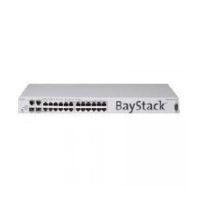215658-B
20
Initial switch setup
The BayStack 425 switch begins switching as soon as you attach network devices
and connect the switch to power. To manage the switch over the network or to
perform TFTP operations, you must set certain IP parameters. Refer to document
Using the BayStack 425 Switch Software for more information about the console
menus and configuring your switch.
Setting IP parameters
For the initial setup of a standalone switch or a stack configuration, you must set
the following IP parameters:
• IP address of the switch or the stack
• Subnet mask
• Gateway address
To set the IP parameters:
1 Connect a terminal to the Console port on the switch.
You can use any terminal or PC with a terminal emulator as the management
station. Be sure the terminal has the following features:
—9600 bits per second (b/s), 8 data bits, 1 stop bit, no parity, no flow control
—Serial terminal-emulation program such as Terminal or Hyperterm for
Windows NT* Hyperterm for Windows*95 or Windows 98.
—Cable and connector to match the male DTE connector (DB-9)on the
BayStack 425 switch console port.
2 Set the terminal protocol:
—VT100 Arrows checked in the Terminal Preferences window under
Terminal Options, and Block Cursor unchecked; VT-100/ANSI checked
under Emulation.
A (Activity)
Green (blinking) There is activity on this port.
Off There is no activity on this port.
Table 8 SFP GBIC Port LEDs on the BayStack 425 (continued)
Label Color/Status Meaning
book.book Page 20 Thursday, July 29, 2004 10:07 PM

